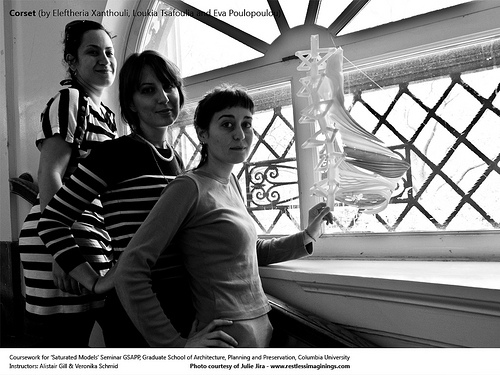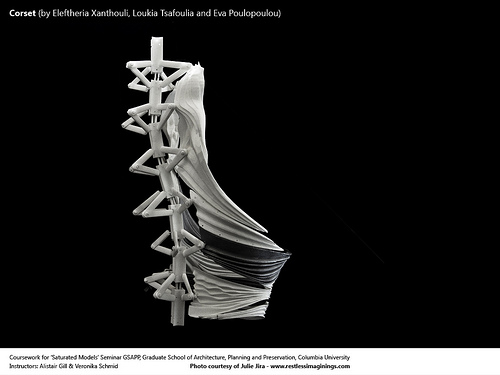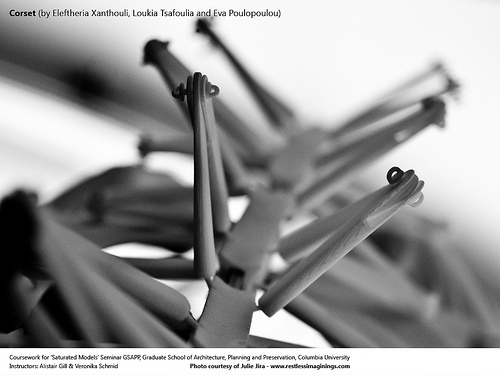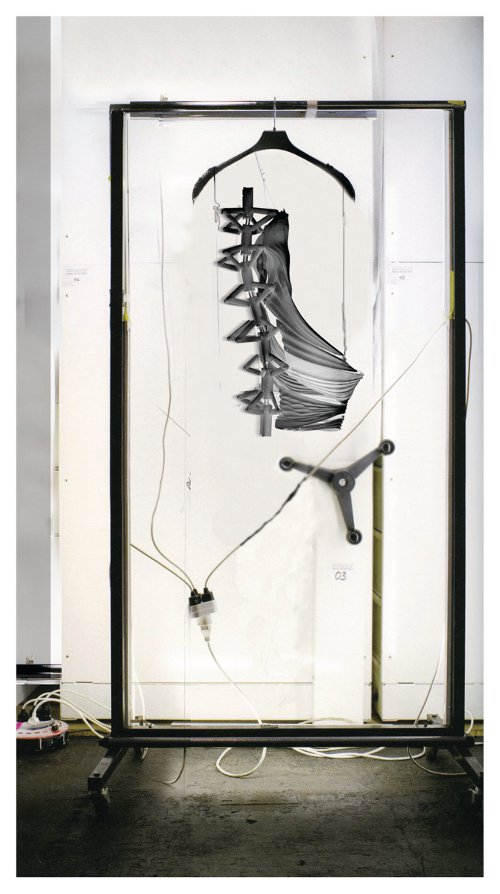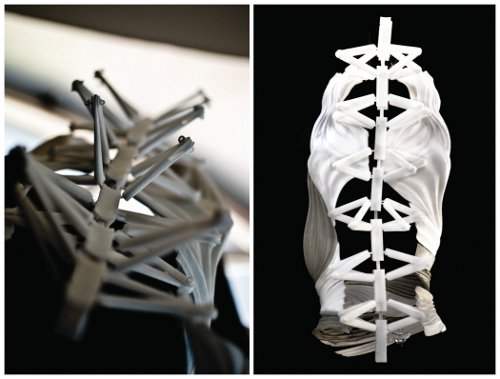Columbia GSAPP Saturated Models 3D printed: Corset
Alistair Gill and Veronika Schmid held a Saturated Models seminar at Columbia”s Graduate School of Architecture, Planning and Preservation. During the seminar the Master”s students explored 3D printing and created 3D printed objects. i.materialise supported the project and we were amazed and impressed with the results. To showcase them we will be doing a series of interviews with the participating architects starting with the Corset team. Â
1. What is Corset?
We produced an object. This object doesn’t consist of its material aspects but of relationships between the atmosphere, between the infinite number of possible qualities / properties / situations that can be attached to it. We produced a corset. Our corset enters into a machinic assemblage with the human body. It extends therefore beyond any earlier distinction between the mechanical and the organic and includes both domains. There is a dual relation between the body and the object. The body forms and deforms and the object captures those deformations. In such an epidemic system where the boundaries between human and object are transgressed, we are talking about a new type of body/machine/coexistence.So, at last the corset is an attempt to turn a simple piece of clothing into a fashion/art object. There is a conscious effort to re-interpret the function, the materiality and the very structure of it.
2. What was the process by which you came to your design?
Conceptually, we started from the Deleuzean ‘body without organs’, corps-sans-organs that refers to the body of the energies and becomings of the earth. The deterritorialized body, is the body of Duchamp’s naked body in Nude Descending the staircase; a body that is captivated through a nebula of movement. The concept of this blurriness and fluidity is the driving force of the design of our model; a model that after is produced is still able to adjust.
Regarding the actual design project, we first modeled a draft in rhino using a random 3d human body and came up with the concept of a rigid re-configurable fabric and the modifiable mechanical verterbrae holding the object together on the back. Then we used an existing corset pattern which we modified to create our object”s particular shape and re-modeled our parts after the new pattern.
3. Why did you make it?
The model chosen to be constructed is a piece of garment that was envisioned to incorporate two mechanisms; a vertebrae system of articulation and an inflatable system of expansion or contraction. Since the object-model is to be exhibited, the process of its design is open to feedback that will be gained throughout the discussion and the comments of its viewers. But it is in the intention of its designers not to cease the forming of the object at the point of its current actualization.The comments will provide an update to its design.The corsette will attempt to reconstruct its body in order to actualize multiple other possibilities that were on the table of its conceptualization. In this sense, the object will become a mean of negotiation where all the possible -suggestions will attempt to be actualized in multiple forecoming forms designed collectively.
We definitely wanted to make a fashion object, but approach it in a different way, using mechanical and rigid parts instead of conventional fabric. The corset was inevitably what we decided to work on since it is directly linked to the idea of rigidity.
4. What software did you use to make it? Rhino, Maya.
5. Will you be using 3D printing more often in the future? Sure, it is a great way of making/exploring non-standard geometries both for art and architecture.
6. Who are you?
Eva Poulopoulou (Athens, 1980) is a licensed greek architect . She recently graduated with a Master of Science in Advanced Architectural Design from the Graduate School of Architecture,Planning and Preservation , Columbia University, with a fellowship from the State Scholarship Foundation. She obtained her professional degree in Architecture from National Technical University of Athens in 2005, spending one year as an exchange student in the Ecole d’ Architecture de Paris – la Villette. She also obtained a Post-Graduate Certificate of Specialized Studies in Digital Arts from the Ecole Nationale Superieure des Arts Decoratifs in Paris, France in 2007. From 2006 to 2007 she worked as a visual artist in Paris for “La Cinematheque Francaise” , while from 2007 to 2010 she has worked as an architect for several firms in Athens, Greece.
Loukia Tsafoulia (Athens, 1984) is a licensed greek architect . She recently graduated with a Master of Science in Advanced Architectural Design from the Graduate School of Architecture,Planning and Preservation, Columbia University, with a fellowship from Gerondelis Foundation. She obtained her professional degree in Architecture from National Technical University of Athens in 2010, spending one year as an exchange student in the Universidade NOVA de Lisboa, Portugal. From 2007 to 2008 she worked in research programs in the Laboratory of Urban Environment, Department of Urban and Regional planning in National Technical University of Athens , while from 2007 to 2010 she has worked as an architect for a firm in Athens, Greece.
Eleftheria Xanthouli (Mitilene, 1984) is a licensed greek architect . She recently graduated with a Master of Science in Advanced Architectural Design from the Graduate School of Architecture,Planning and Preservation , Columbia University, with a fellowship from Gerondelis Foundation. She obtained her professional degree in Architecture from National Technical University of Athens in 2009.
Recommended Articles
No related posts.


